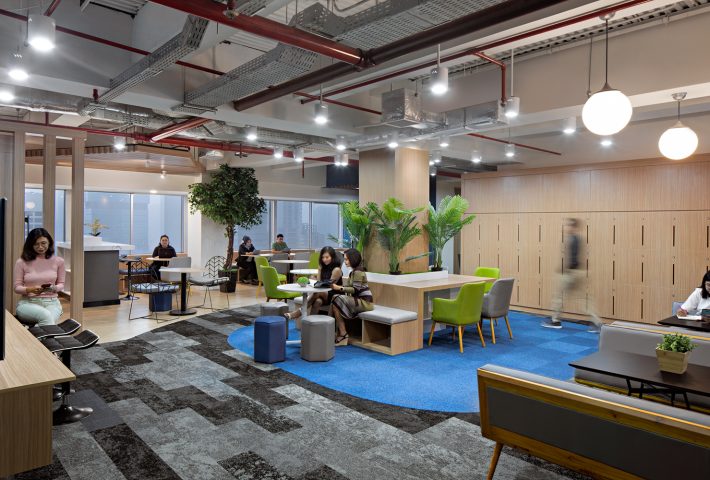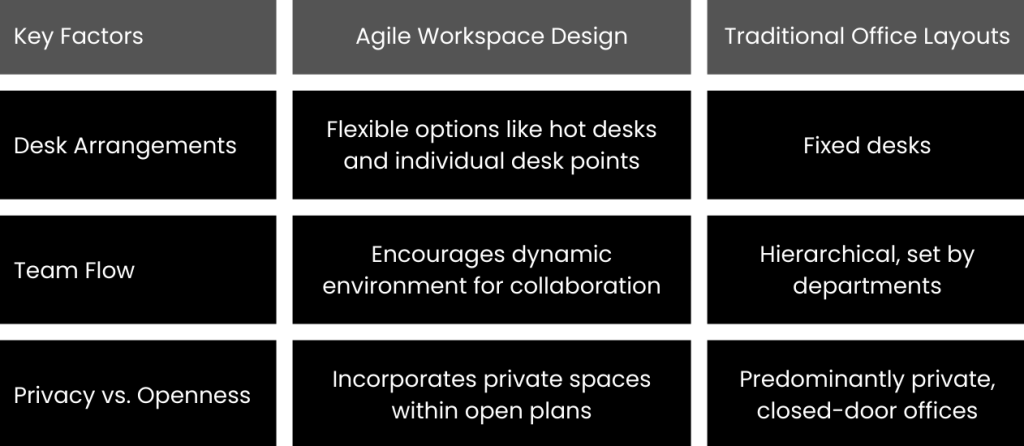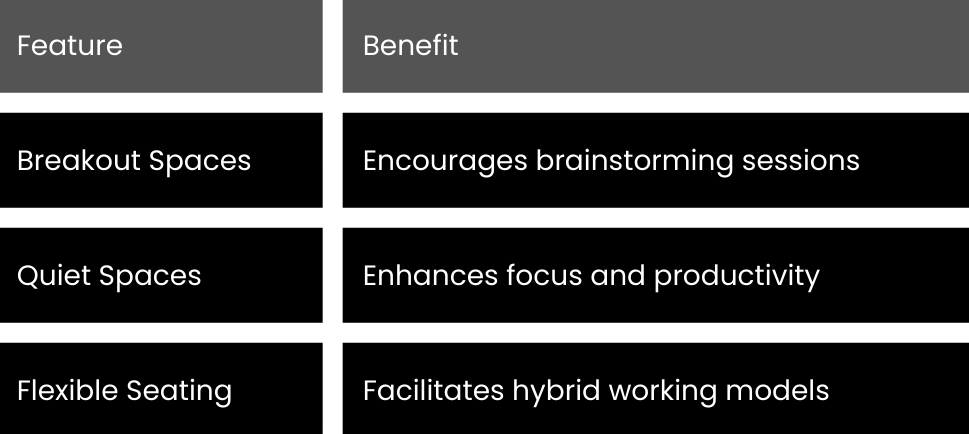
In this article, we delve into what Agile Workspace Design truly entails and explore the compelling reasons your office should adopt this forward-thinking approach. We will compare it to traditional office layouts, highlight its key components, and address common challenges. Whether you’re an innovative startup or a well-established corporation, understanding Agile Workspace Design can be your gateway to a future-proof, efficient, and engaging workplace.
What Is Agile Workspace Design?
Agile Workspace Design is an innovative approach to office layouts, inspired by Agile principles initially adopted by tech and startup industries. This concept focuses on creating dynamic and flexible environments that enhance collaboration, creativity, and employee satisfaction.
Core Features:
- Modular Furniture: Easily movable pieces to support reconfiguration for various tasks.
- Flexible Seating/Hot Desking: Employees choose where to work, aligning with hybrid work models.
- Activity-Based Zones: Specific areas for brainstorming sessions, deep focus, or relaxation.
- Collaboration and Breakout Spaces: Designed to foster teamwork and creative problem-solving.
Consider a hypothetical office that features modular desks, comfortable seating areas, and various spaces, including quiet zones and vibrant breakout areas, to accommodate a diverse range of tasks and activities. Such an agile office design not only boosts job satisfaction but also enhances employee well-being.
Globally, agile workspace design has gained momentum, with Singapore quickly adopting this approach. As workplaces evolve post-pandemic, flexible space arrangements align with the hybrid working model.
For businesses seeking expertise, ID Integrated stands as a trusted guide in executing modern and effective agile workspace designs.
Benefits of Agile Workspace Design for Your Business
Agile workspace design offers a range of benefits for businesses seeking to stay competitive and adapt to changing work paradigms. By integrating flexibility and functionality into office layouts, companies can create environments that not only meet current needs but also anticipate future changes. Central to this is the design’s ability to foster collaboration, maximize space efficiency, enhance employee satisfaction, and accommodate evolving work trends. As businesses strive to align with these dynamic demands, agility in workspace design stands as a strategic enabler for growth and sustainability.
Boosts Collaboration and Creativity
In an agile workspace, fostering spontaneous collaboration becomes an everyday norm. These environments are structured with open layouts and team-oriented zones, making it easy for employees to work together. In place of conventional office structures, which often restrict interaction, agile spaces promote fluidity and immediacy in exchanges.
This approach inspires creativity as team members feel empowered to brainstorm and share ideas openly, leading to innovative solutions and dynamic problem-solving. ID Integrated’s experience in designing modern workplaces highlights how implementing such environments can lead to greater employee engagement and productivity.
Improves Space Efficiency
Maximizing space efficiency is a crucial advantage of agile workspace design, especially in high-rent cities like Singapore. With real estate costs continually rising, businesses are compelled to use their office space optimally. Agile designs emphasize multipurpose areas and modular configurations that allow spaces to be redefined for varying needs without the constant expense of refitting.
By creating adaptable environments with flexible layouts, businesses can reduce overhead costs and ensure spatial limitations do not hinder their operations. This cost-effective approach not only conserves resources but also reflects a commitment to sustainability.
Enhances Employee Satisfaction
Flexible workspaces significantly enhance employee satisfaction, as employees thrive in environments that cater to diverse working styles. A wealth of data suggests that agility in office design correlates with improved morale and productivity.
In particular, flexible environments that offer choices, such as quiet zones for deep focus and communal areas for interaction, are instrumental in meeting individual preferences and work patterns. ID Integrated prioritizes a human-centered design philosophy, recognizing that satisfied employees are more engaged and contribute to a positive and productive work environment.
Future-Proof Your Workplace
Adopting an agile workspace design is a strategic move to future-proof your workplace. Such setups are inherently designed to support hybrid work models and can adapt seamlessly to evolving team needs. As businesses continue to navigate post-pandemic challenges, the agility of office designs ensures that workspaces remain relevant and functional.
This forward-thinking approach enables organizations to respond quickly to changes in technology, workforce dynamics, and business objectives. With the guidance of experts like ID Integrated, companies can confidently transform their offices into dynamic spaces that are ready to tackle future challenges effectively.
Agile Workspace Design vs. Traditional Office Layouts
In tuning their environments, businesses today face a choice between agile workspace designs and traditional office layouts. Each comes with distinct features:

Agile office designs foster a hybrid working model, appealing to tech firms, creative agencies, and startups. These designs encourage flexibility, collaboration, and dynamic spaces, crucial in today’s post-pandemic world where hybrid work is becoming the norm. Notably, in Singapore, the adoption of agile environments is on the rise, partly inspired by businesses prioritizing employee satisfaction and well-being.
Statistics show that companies with agile workspaces often see a 20% increase in productivity and employee satisfaction. In such scenarios, ID Integrated emerges as a leader, offering insightful solutions for modern office design that blend innovative functionality with a focus on employee well-being.
For organizations looking to stay ahead of evolving workplace trends, agile workspace design offers a promising path to creating a responsive and empowering work environment.
Key Elements of an Agile Workspace
Agile workspace design is transforming how organizations approach office layouts, blending the practicality of flexible working models with the need for dynamic environments. As companies evolve post-pandemic, incorporating these elements can significantly enhance employee satisfaction and productivity.
This framework offers a range of spaces where employees can easily transition between different tasks, supporting a hybrid working model. By focusing on flexible furniture, activity-based zoning, integrated technology, and design that prioritizes comfort and wellness, businesses can create responsive, modern workplaces that cater to diverse needs and preferences.
Flexible Furniture
Flexible furniture is a cornerstone of agile workspace design, addressing the necessity for adaptability in dynamic work environments. As businesses shift toward hybrid work structures, the emphasis is on creating spaces that easily adapt to evolving needs. This includes incorporating adjustable desks, mobile elements, and movable dividers, ensuring that these components cater to various work styles and preferences.
Adjustable desks, which allow employees to switch between sitting and standing positions, are crucial in promoting health and comfort. Mobile elements, such as rolling chairs and tables, enhance the ability to reconfigure spaces for different tasks and group sizes. Moveable dividers offer the flexibility to create private spaces or open areas as required, facilitating focused work or spontaneous collaboration. By integrating these features, offices can foster a dynamic environment that supports creativity and efficiency.
Activity-Based Zoning
Activity-based zoning represents a strategic approach to organizing workspace layout, tailored to support multiple types of activities within an office. In today’s agile work environment, it’s essential to create areas that are purposefully designed for focus, collaboration, and relaxation, meeting the diverse needs of employees.
Dedicated zones for focus allow employees to engage in deep work without distraction, often featuring quiet spaces or soundproof pods. Collaboration spaces, on the other hand, are designed to foster team brainstorming sessions, equipped with comfortable seating and necessary tools for group work. Rest areas provide a much-needed sanctuary for employees to unwind, recharge, or engage in informal interactions. By effectively implementing activity-based zoning, businesses can ensure that their offices accommodate a range of working styles, which in turn enhances overall employee satisfaction.
Integrated Technology
The seamless integration of technology within an agile workspace is vital to maintaining efficiency and connectivity. As more organizations embrace flexible and hybrid work models, the demand for robust technological infrastructure increases. Essential elements include wireless connectivity, advanced AV tools, and brilliant desks, each enhancing the modern work environment.
Wireless connectivity ensures that employees can access networks anywhere within the office, supporting mobility and flexibility. Advanced AV tools facilitate virtual meetings and presentations, bridging the gap between remote and on-site workers. Smart desks, equipped with digital interfaces, enable individualized setups, allowing employees to personalize their workspaces. By integrating these technological features, businesses can ensure a seamless and efficient operational flow within their workspace.
Comfort & Wellness Design
Designing for comfort and wellness is increasingly recognized as essential in creating a supportive work environment that promotes employee well-being. In agile offices, the emphasis is on creating spaces that promote physical and mental health through thoughtful design elements, including lighting, biophilic features, and ergonomic setups.
Adequate lighting, preferably natural, is fundamental in sustaining alertness and reducing eye strain. Incorporating biophilic elements, such as plants or nature-inspired decor, can improve mood and reduce stress. Ergonomic setups—featuring chairs and desks that support proper posture—are essential in preventing workplace injuries and promoting long-term health. By integrating these components into an agile workspace design, businesses can increase job satisfaction and improve employee well-being, ultimately leading to a more productive and engaged workforce.
Common Challenges and How to Overcome Them
Implementing an agile workspace design can introduce challenges, such as noise distractions from open plans and adjustment difficulties for teams accustomed to traditional office layouts. However, these challenges are not insurmountable.
Solutions to Overcome Common Challenges:
- Noise Distractions:
- Solution: Incorporating phone booths and acoustic panels can significantly reduce noise levels, creating a more focused environment.
- Adjustment Difficulties:
- Solution: A gradual implementation plan allows teams to adapt over time. ID Integrated specializes in managing these transitions, ensuring a smooth shift to agile workspaces.
This approach minimizes disruption and enhances employee satisfaction by fostering a dynamic environment. By addressing these common concerns, businesses can reap the benefits of an agile workplace, including the creation of a collaborative space that fosters modern work practices.
Is Agile Workspace Design Right for Your Business?
In the rapidly evolving modern workplace, businesses are embracing agile workspace design to foster a dynamic and flexible work environment. An agile workspace features a layout that supports various work styles, with a focus on collaboration, quiet areas, and breakout spaces. This approach is becoming increasingly relevant globally and is being notably adopted in Singapore as businesses adapt to post-pandemic trends, such as hybrid working models.
Checklist:
- Growing or Hybrid Teams: Is your team expanding or transitioning to a hybrid work model?
- Space Optimization: Do you need to make better use of your existing office space?
- Collaborative Culture: Is fostering collaboration and creative brainstorming a core part of your work culture?
A key trend shows that 74% of businesses plan to permanently adopt a hybrid working model, highlighting the need for flexible space solutions.
With a focus on employee well-being and satisfaction, agile office designs offer a pathway to a more dynamic environment. According to ID Integrated, a leader in modern office design, transitioning to an agile workspace can enhance both productivity and morale.
If these considerations resonate with your business needs, it might be time to consider upgrading to an agile workspace.
Transform Your Office with ID Integrated
Agile workspace design is transforming how businesses operate, prioritizing flexibility, collaboration, and employee satisfaction. An agile workspace features dynamic environments with breakout spaces, quiet areas, and flexible seating options, such as hot desks and individual desks.
Globally, the relevance of agile workspaces is increasing, and Singapore is no exception. The shift towards hybrid working models post-pandemic has accelerated this trend. According to recent studies, over 70% of companies now recognize the importance of agile office layouts to foster innovation and adaptability.
Here’s how ID Integrated can help:
- Regional Expertise: With extensive experience in Southeast Asia, ID Integrated has executed notable projects, crafting tailored office spaces that align with business goals.
- Strategic Design: We integrate flexible work environments that promote employee well-being and job satisfaction.
Key Elements of Agile Workspace Design:

Let ID Integrated guide your office transformation. Let’s create an office that grows with your business. Book your consultation with ID Integrated today.



